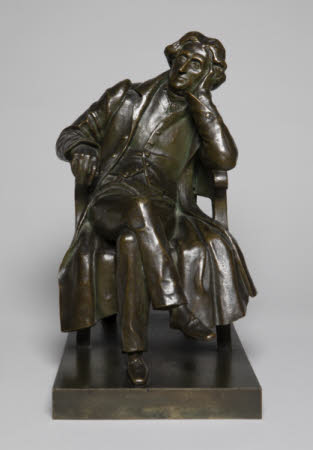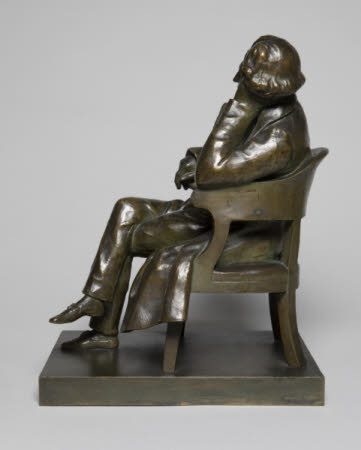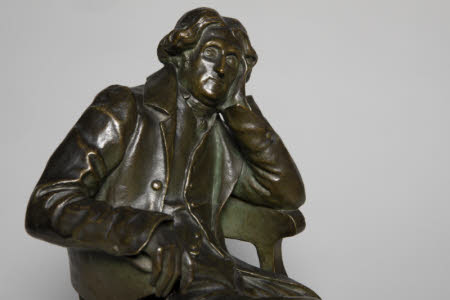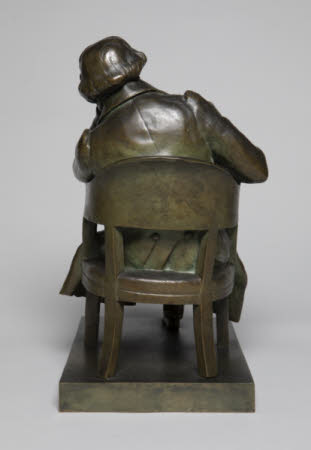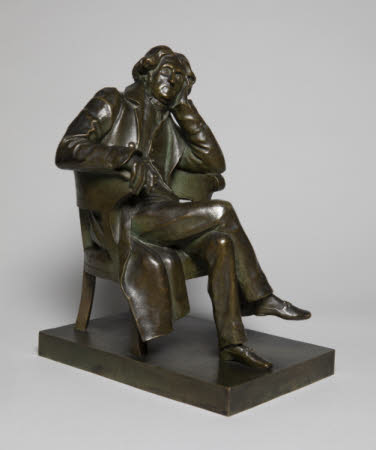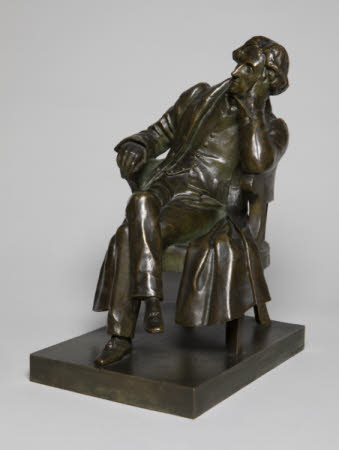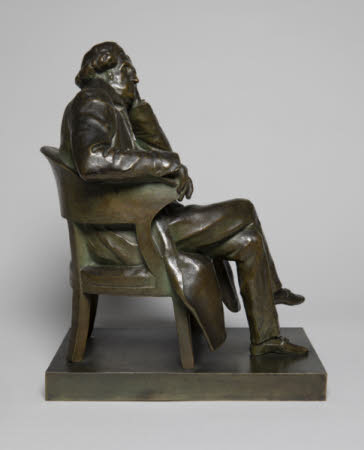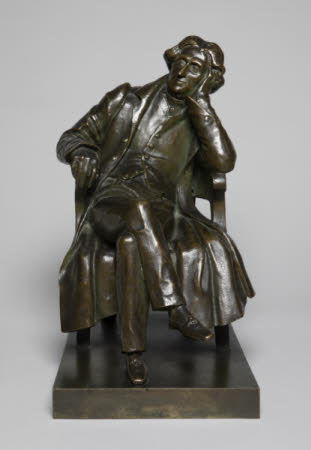Portrait of the historian Carlo Giuseppe Guglielmo Botta (1766-1837)
Baron Carlo Marochetti, RA (Turin 1805 – Passy, Paris 1867)
Category
Art / Sculpture
Date
c. 1832
Materials
Bronze
Measurements
355 mm (H); 205 mm (W); 305 mm (D)
Place of origin
Paris
Order this imageCollection
Kingston Lacy Estate, Dorset
NT 1255215
Summary
Sculpture, bronze; portrait of Carlo Giuseppe Guglielmo Botta (1766-1837); Carlo Marochetti (1805-1867); c. 1832. A bronze statuette of the Italian historian Carlo Giuseppe Guglielmo Botta, by the Italian-born sculptor Baron Carlo Marochetti. Both men were born in Piedmont in Northern Italy, but spent much of their liuves and careers based in Paris. Marochetti was a close friend of the older man, once describing him as a second father. The sculpture was sent by Marochetti to William John Bankes in around 1840, as a demonstration of the sculptor’s ability to produce bronze casts, at the time of the competition to choose a sculptor to make the monument to the Duke of Wellington in Glasgow.
Full description
A bronze statuette by Carlo Marochetti (1805-1837) depicting the Italian historian Carlo Giuseppe Guglielmo Botta (1766-1837). Botta is shown seated in a round-backed chair, wearing a long frockcoat with a tightly-buttoned waistcoat. His legs are crossed, his right hand on the arm of the chair, whilst his left arm rests on the other arm of the chair, his head supported on his hands. With long wavy hair, he looks sharply to his right. The rectangular base is separately cast, the figure attached to the base by means of screws. The surface of the bronze is enlivened with hammering and other afterwork to the surface. Carlo Botta was an eminent historian and an active participant in the revolutionary politics of the 1790s in Europe. Born in Turin and having first trained as a doctor, Botta was for a while imprisoned for his Jacobin revolutionary beliefs. On his release he promptly joined Napoleon’s army, as it began its invasion of Italy. After the annexation of Piedmont by France, Botta spent time both in Paris and in Turin, where he became a member of the French-installed Piedmontese administration. He continued to support Napoleon until his final fall in 1815, after which date Botta settled for the rest of his life in Paris, working as an historian. Among his works are an important history of Italy during the years of the French Revolution and Napoleon (Storia d’Italia dal 1789 al 1814, Paris 1824), as well as a history of Italy in the seventeenth and eighteenth centuries (Storia d’Italia continuata da quella del Guicciardini, Paris 1832). Although over time Botta gradually distanced himself from the more radical views of his youth, he remained a liberal and a firm republican. Carlo Marochetti had an especially close relationship with Carlo Botta. When after the historian’s death the city of Turin decided to erect a monument to him in his birthplace of the parish of San Giorgio Canavese, Carlo Marochetti wrote to request the awarding to him of the commission (as indeed duly happened), explaining in his letter that ‘Carlo Botta was a second father to me’ (‘Charles Botta était un second père pour moi’, Dionisotti 1867, p. 497). In fact Marochetti’s father Vincenzo (1768-1822) had, during the short-lived Republic of Piedmont in 1798-99, served as secretary-general to the Executive Commission, of which Botta was President. Both families subsequently settled in Paris and maintained close connections, Botta often staying in the château at Vaux-sur-Seine, that Vincenzo Marochetti had bought in 1819. After his father’s death in 1822, Carlo Marochetti became ever closer to Carlo Botta, from 1821 even sharing a house with the Botta family in the rue de Vaugirard. So he would have had ample opportunity to study the subject of this portrait. The small bronze statuette of Botta seated was made by Carlo Marochetti in around 1832, when the sitter was in his late 60s. It was considered an excellent likeness by Botta’s biographer Carlo Dionisotti, who wrote of his appearance that ‘he was tall, with a broad forehead, his eyes full of cleverness, his expression gentle, his whole face breathing an air of nobility and well-meaning dignity (‘Botta era alta di statura, spaziosa la fronte, l’occhio arguto, dolce lo sguardo, e dal suo viso traspariva un’aria di nobiltà e dignità affettuosa’ Dionisotti 1867, pp. 492-493). One other version of the sculpture is known, in the collection of Carlo Marochetti’s descendents at Vaux-sur-Seine and reproduced in a volume of Carlo Botta’s letters (Botta 1873). Both casts would have been cast by Marochetti who, unlike most contemporary sculptors, throughout his career personally undertook the casting of many of his bronzes, including the three great figures of Sir John and Lady Bankes and King Charles I at Kingston Lacy (NT 1255195). The second version of the statuette at Kingston Lacy, long mistakenly identified as a portrait of Lord Eldon or of William John Bankes, was sent by the sculptor to Bankes, an active and vociferous supporter of Carlo Marochetti’s bid for the commission to make the equestrian statue of the Duke of Wellington for the city of Glasgow. A committee was established in 1840 to oversee the erection of the Glasgow monument to the Iron Duke, a sub-committee shortly afterwards beginning the process of selecting a sculptor, out of what was at first a long list of British and foreign artists. Carlo Marochetti was at this time basking in the glory of the success of his equestrian monument to Emanuele Filiberto, Duke of Savoy, installed on Piazza San Carlo, Turin in 1838. He very quickly emerged as the front-runner, although some members strongly opposed the selection for this prestigious commission of a foreign artist. Marochetti’s success evidently owed quite a lot to William Bankes who, although not a member of the committee, quickly made it known that he was acquainted with Marochetti and was asked to act as the intermediary between the sub-committee and the sculptor. Bankes and Marochetti had come to know each other before 1839 when in a letter of 30 May, Marochetti referred to their previous meeting in Paris. For the Glasgow commission, Bankes also took it upon himself to extoll Marochetti’s virtues to Wellington’s family, going so far as to arrange for Marochetti to have an early sitting with the Duke, before he had even been formally chosen for the project. Bankes was outspoken in his enthusiasm for Continental art, declaring in evidence to a Parliamentary Select Committee on the Fine Arts that he felt himself to be on a mission to promote, within his own country, bronze sculpture as it was practised in Paris. In a letter of 19 August 1840 to William Bankes (Dorset History Centre, Bankes Papers, HJ/1/579), Robert Lamond, secretary of the Glasgow sub-committee, referred to assurances as to his skills and suitability for the commission that the committee had received from Marochetti, who had referred to a work of his that demonstrated his abilities in the modelling and casting of bronze. Lamond wrote that ‘I venture on my own responsibility as a private member of the committee to say to you, that if it did not put him to any great trouble or expense it might be in his favour, so far as regards a proper and just estimate of his work, that he enabled you to furnish us with the model that he speaks of…’ In his next letter of 9 September (HJ/1/580), Lamond gave Bankes instructions for the dispatch of the work to him, adding that ‘The Committee are under great obligations to you for the interest and trouble you have taken in this matter…’. Although it is possible that Bankes already owned the bronze by this time, it seems most likely therefore that Carlo Marochetti sent the bronze figure of Botta to Bankes around this time, specifically so it could be shown to the Glasgow committee. The sharply differing views that became evident on the sub-committee soon found their way to the pages of the Glasgow Constitutional. These were followed by a series of excoriating articles in the Art Union, which was not only fiercely opposed to the selection of a foreign artist but also, like others, believed that the choice of Marochetti had involved an element of skulduggery. In its May 1841 issue (pp. 83-84), the Art Union commented on a number of sculptures and drawings by Marochetti that had been brought to a recent meeting of the committee, ‘which Mr Charles Hutchison justly denounced as the veriest trash which he had ever had the opportunity of seeing.’ They included three small bronzes, an equestrian statuette of Napoleon, the 'Arabe pleurant son coursier' and, thirdly, the bronze statuette of Botta, witheringly described as ‘a lackadaisical figure of an old gentleman seated in an arm chair, which some of the members took for a statue of Mr. Bankes, of Corfe Castle, late M.P. for Dorsetshire, who, it appeared in the course of these proceedings, had been mainly instrumental in forcing the Baron Marochetti upon the good people of Glasgow. Jeremy Warren August 2023
Provenance
Given by the sculptor to William John Bankes (1786-1855), probably in 1840; by descent to Ralph Bankes (1902-1981), by whom bequeathed in 1981.
Makers and roles
Baron Carlo Marochetti, RA (Turin 1805 – Passy, Paris 1867), sculptor
References
Dionisotti 1867: Carlo Dionisotti, Vita di Carlo Botta, Turin 1867, p. 493. Botta 1873: Lettere di Carlo Botta al conte Tomasso Littardi, Genoa 1873 Ward-Jackson, 1990: Philip Ward-Jackson . “Carlo Marochetti and the Glasgow Wellington memorial.” Burlington Magazine 132 (1990), pp. 851-862., pp. 851-862, pp. 856-57, fig. 35. Roscoe 2009: I. Roscoe, E. Hardy and M. G. Sullivan, A Biographical Dictionary of Sculptors in Britain 1660-1851, New Haven and Yale 2009, p. 805, no. 61.
